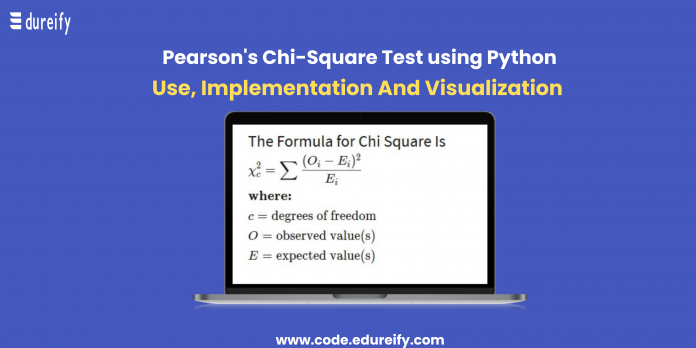Machine Learning requires a lot of statistical and strategic analysis. Hypothesis testing of Machine Learning is a must when it comes to inferencing a population parameter or population parameter distribution. Hypothesis testing has many types and one of them is the chi-squared test.
Edureify, the best AI Learning App provides comprehensive coding courses that teach students all the skills regarding the various programming languages and their tools. In this article, Edureify will discuss the chi-squared test to better inform the students about the formula and its uses.
What is the Chi-Square Test?
The Chi-Squared Test, which is symbolically represented as X2, is a form of data analysis that observes the variables of random sets. It is a statistical procedure that determines the difference between expected and observed data. The Chi-Squared Test also helps understand the difference between two categorical variables is because of a relationship between them or just a chance.
Formula of Chi-Square
xc2= Ʃ (Oi – Ei)2 / Ei
Here,
c= Degrees of freedom
O= Observed Value
E= Expected Value
In a statistical calculation, the degrees of freedom represent the number of variables that might vary in a calculation. To ensure the chi-square tests are statistically valid, the degrees of freedom are calculated.
Uses of Chi-Squared Test
Some of the uses of the Chi-Squared Test are-
- It helps decipher whether the data, like the Normal or Poisson distribution, follows their well-known theoretical probability distribution
- It enables one to assess their trained regression models to fit the training, validation, and test data sets
- Deciphers whether two criteria of classification are independent of the qualitative variable
- Understand the relationship between categorical variables
Types of Chi-Squared Test
There are mainly two types of the Chi-Squared Test and both use the chi-square distribution and statistics for different purposes. The two types are-
- A Chi-Square Goodness fit test– this test determines whether the sample data match a population
- A Chi–Square Test for Independence– this test observes two variables in a contingency table to find out whether they are related or not. It also helps to see whether the distribution of categorical variables differs from one another.
Limitations of Chi-Square Test
Before beginning to use the Chi-Square test, one must know about its two limitations. They are-
- To begin with, the test is sensitive to sample size. In some cases, an insignificant relationship can seem statistically significant when a large sample is used. One must understand that “statistically significant” is not always meaningful.
- The test helps determine whether two variables are related. It need not be the case that one variable has a casual relationship with the other.
Example of Chi-Square Test
In the following example let us consider that in a college election two clubs- literature and sports, have anything to do with the winning party preference. We take 440 voters in a simple random sample in a college to find out which party wins. The result of the vote is given below-
| Club | The Culture Association | The United Students | The Inclusive Party | Total |
| Literature Club | 100 | 70 | 30 | 220 |
| Sports Club | 140 | 60 | 20 | 220 |
| Total | 240 | 130 | 50 | 440 |
To find out whether the clubs are related to the party’s preference, we will conduct the Chi-Square test.
Solution:
Step 1-
Define the Hypothesis-
H0- the clubs and party are not related
H1- the clubs and party are related
Step 2-
Calculate the expected frequency
Expected Value= (Row Total) * (Column Total) / Total Number of Observations
For example, the expected value for Literature Club The Culture Association is-
= (240) * (200) / 440= 109
Therefore,
Expected Values are-
| Club | The Culture Association | The United Students | The Inclusive Party | Total |
| Literature Club | 109 | 59 | 22.72 | 200 |
| Sports Club | 120 | 65 | 25 | 220 |
| Total | 240 | 130 | 50 | 440 |
Step 3-
Calculate (O-E)2 / E for each of the cells in the table
Therefore,
| Club | The Culture Association | The United Students | The Inclusive Party | Total |
| Literature Club | 0.74311927 | 2.050847 | 2.332676056 | 200 |
| Sports Club | 3.33333333 | 0.384615 | 1 | 220 |
| Total | 240 | 130 | 50 | 440 |
Step 4-
Calculate the test statistics X2
Here, X2 is the sum of all the values in the last table
= 0.743 + 2.05 + 2.33 + 3.33 + 0.384 + 1= 9.837
Before drawing the final result, one must determine the critical statistics that require the determination of the degrees of freedom. The degrees of freedom here are equal to the table’s number of columns minus one multiplied by the table’s number of rows minus one, or (r-1) (c-1). We have (3-1)(2-1) = 2.
Here was the Chi-Square Test formula and example.
To learn more about Machine Learning and its tools, join Edureify’s certified coding courses. It has courses on-
- Azure Machine Learning
- Machine Learning Algorithms
- No-Code Machine Learning
- The A-Z Statistics of Machine Learning,
- ANOVA, and other important programming languages and tools.
With Edureify’s coding courses, students can also benefit from-
- 200+ learning hours
- Live classes with the industry experts
- Doubts solved instantly
- Participate in real-life projects
- Get professional career guidance
So join the best coding courses with Edureify and kick-start your coding career.
Some FAQs on Chi-Square Test-
1. What is the Chi-Square Test?
The Chi-Square Test is a form of data analysis that observes the variables of random sets. It is a statistical procedure that determines the difference between expected and observed data. The Chi-Squared Test also helps understand the difference between two categorical variables is because of a relationship between them or just a chance.
2. What is the symbolical representation of the Chi-Square Test?
X2 is the symbolical representation of the Chi-Square Test.
3. What is the formula of the Chi-Square Test?
The formula of the Chi-Square Test is-
xc2= Ʃ (Oi – Ei)2 / Ei
4. Mention the types of Chi-Square tests.
There are two types of Chi-Square tests. They are-
- A Chi-Square Goodness fit test
- A Chi-Square Test for Independence
5. From where can I learn more about the Chi-Square Test?
Study with Edureify’s best coding courses to learn more about Chi-Square Test.
Master Your Coding Skills with BootSelf AI
If you're looking to enhance your coding abilities and upskill in artificial intelligence, look no further than the BootSelf AI app. This innovative platform provides AI-based coding lessons that are tailored to your individual learning pace.
Available on both iOS and Android, you can download the BootSelf AI app and start mastering coding skills today:












